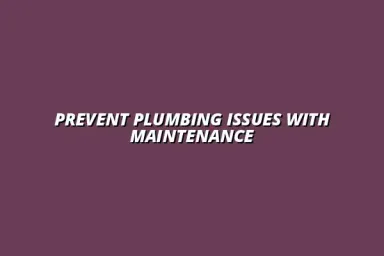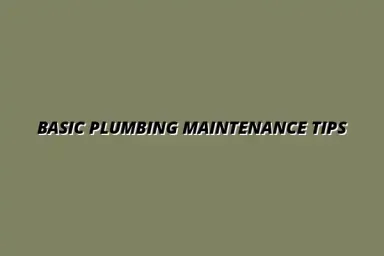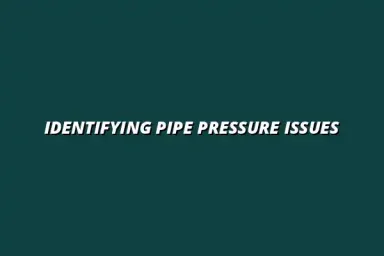Understanding Frozen Pipes and Their Causes
Frozen pipes can be a nightmare for homeowners, especially during the cold months. When the temperature drops, the water inside the pipes can freeze, causing a host of problems that can lead to significant damage. To tackle this issue effectively, it's essential to understand what causes pipes to freeze and the impact this can have on your home.
Typically, pipes freeze when the temperature falls below 32°F (0°C). Areas in your home that are poorly insulated, such as basements, attics, or exterior walls, are especially prone to freezing. When water freezes, it expands, putting tremendous pressure on the pipe walls, which can lead to cracks or bursts. For more information on preventing frozen pipes this winter, check out these helpful preventative measures.
The Impact of Frozen Pipes on Your Home
Frozen pipes can have serious consequences for your home structure and finances. When a pipe bursts due to freezing, it can cause water to flood your home, leading to extensive damages. This not only results in costly repairs but can also disrupt your daily life.
Additionally, the aftermath of a burst pipe can lead to mold growth if the water isn't managed promptly. Mold can create a health hazard and further increase repair costs, so understanding the impact of frozen pipes is crucial for any homeowner. Learning how to detect hidden pipe leaks is vital; you can find out more about detecting hidden pipe leaks at home here.
- Water damage to walls and flooring
- Increased risk of mold growth
- Costs associated with repairs and replacements
How Frozen Pipes Can Lead to Water Damage
When water freezes inside a pipe, the pressure builds up until the pipe can no longer hold it, often resulting in a burst. Once the ice has thawed, the water will start to flow, causing immediate flooding in your home. This can damage walls, ceilings, and valuable possessions. Understanding the causes of bursting water pipes can help you prevent future issues.
Addressing the damage from a burst pipe can be a lengthy and expensive process. It often involves not only repairing the pipe but also dealing with any subsequent water damage. To avoid this, it’s essential to take preventive measures before the cold weather hits.
Recognizing the Signs of a Frozen Pipe
Being able to identify a frozen pipe early can save you from significant headaches later. Look out for certain signs that indicate trouble. For example, if you turn on a faucet and only a trickle comes out, it could mean that the pipe is frozen somewhere along the line.
Other signs include strange sounds as water flows through the pipes or an unusual smell coming from drains. If you suspect a frozen pipe, it's crucial to act quickly to prevent it from bursting. For more beginner tips on dealing with frozen pipes, see our guide on winter plumbing tips for frozen pipes.
- Reduced water flow from faucets
- Unusual sounds in the plumbing
- Frost or condensation on pipes
Preventing Frozen Pipes in Your Home
Now that we understand the potential damage caused by frozen pipes, let’s delve into prevention strategies. Taking proactive steps can help protect your plumbing and prevent costly repairs. Identifying the most vulnerable areas in your property is a great first step!
By knowing where your pipes are most likely to freeze, you can take measures to insulate and shield them from the cold. Winter plumbing tips to prevent freezing can be found here. Below are some common areas where frozen pipes may occur.
Identifying Vulnerable Areas in Your Property
It's crucial to pinpoint the spots in your home that are at a higher risk for freezing. By focusing on these areas, you can implement preventive measures before winter arrives. Here are some common locations to monitor:
- Unheated basements or crawl spaces
- Attics and garages
- Exterior walls with little or no insulation
Common Locations for Frozen Pipes
Pipes located in unheated spaces can freeze easily, so it's essential to keep an eye on them. Some typical areas where this occurs include:
- Outside walls, especially near vents
- Under kitchen and bathroom sinks
- In any plumbing that runs through exterior walls
By identifying these vulnerable spots, you can take steps to prevent freezing before it becomes an issue!
Insulation Solutions for Cold Areas
Insulating pipes is one of the most effective ways to prevent freezing. You can use materials like foam pipe insulation, which is easy to install and offers great protection. For information on preventing corrosion in water heaters, a related preventative measure, see this link. Here are some insulation solutions to consider:
- Wrap pipes with foam sleeves or insulation tape
- Use heated tape for more extreme conditions
- Insulate walls and attics where pipes are located
Implementing these solutions can go a long way in keeping your pipes safe from freezing temperatures.
Dealing with Burst Pipes After Thawing
After a frozen pipe thaws, the consequences can sometimes be severe. One of the most immediate concerns is the potential for a burst pipe, which can lead to significant water damage in your home. Understanding how to identify and manage these issues is crucial for protecting your property and minimizing repair costs!
When a pipe bursts, it’s vital to assess the situation quickly. Knowing the signs of damage can help you react promptly, potentially saving you from further complications. If you need a plumber in Birmingham, UK you can find one here. Keep an eye out for these indicators to stay ahead of the problem.
Identifying Damage After a Pipe Bursts
Detecting water leaks after a pipe bursts is essential to preventing further damage. Here are some common signs that you may notice:
- Water stains on walls or ceilings.
- Puddles forming on the floor, especially near walls.
- Unusual dampness or musty odors in specific areas.
If you see these signs, it's crucial to act quickly! The longer you wait, the more damage can occur. Additionally, assessing the structural risks is vital to ensure your home remains safe.
Signs of Water Leaks Following Thawing
Following the thawing of frozen pipes, watch for specific leak signs. These can include:
- A sudden increase in your water bill without explanation.
- Visible cracks in walls or flooring.
- Wet insulation or mold growth in hidden areas.
Being aware of these signs helps you take action before it escalates into a bigger problem. Early detection can save you from costly repairs later!
Assessing Structural Damage Risks
When water leaks occur, assessing the risk of structural damage is essential. Water can weaken the foundation and framing of your home if left unchecked. Here’s what to consider:
- Check for warping in floors or ceilings.
- Inspect for mold growth in hidden areas.
- Look for soft spots in walls that may indicate decay.
If you suspect any serious damage, it may be best to consult a professional who can evaluate the situation thoroughly. Understanding the risks helps you make informed decisions about repairs!
Repairing or Replacing Damaged Pipes
Once you identify any damage, it’s time to act! Repairing or replacing damaged pipes is crucial to restoring your plumbing system. Knowing when to call a professional can save you time and effort.
Consider these points before deciding:
- If damage is extensive or involves multiple pipes, seek professional help.
- For minor issues, DIY repairs may be manageable.
- Assess your skill level and comfort with plumbing work.
Taking the right approach ensures your home remains safe and functional! Whether going the DIY route or hiring a pro, understanding your options is key.
When to Seek Professional Help for Pipe Repairs
Sometimes, a situation calls for an expert touch. Here’s when you should consider calling a plumber:
- If you can’t locate the source of a leak.
- When multiple pipes are affected by damage.
- If you notice significant structural issues.
Professional plumbers have the expertise to tackle complex problems effectively! They can provide a thorough assessment and recommend the best course of action.
DIY Fixes for Minor Pipe Damage
If the damage is minor, you might be able to handle it yourself. Here are a few simple fixes you can try:
- Use plumbing tape for small leaks.
- Replace any damaged fittings or joints.
- Apply epoxy putty for quick patches.
These DIY methods can effectively manage minor issues, but always proceed with caution. If the problem worsens, don’t hesitate to call a professional!
Frequently Asked Questions About Frozen Pipes
What Are the Best Preventive Measures Against Frozen Pipes?
Preventing frozen pipes is always better than dealing with the aftermath. Some effective measures include:
- Insulating pipes in unheated areas.
- Keeping garage doors closed during cold spells.
- Letting faucets drip slightly during extreme weather.
Implementing these strategies can help keep your pipes safe from freezing!
How Long Does It Take to Thaw a Frozen Pipe?
The time it takes to thaw a frozen pipe can vary based on its size and location. Generally, it might take anywhere from a few minutes to several hours. Patience is key!
Can I Use a Blowtorch on a Frozen Pipe?
Using a blowtorch to thaw a frozen pipe is not recommended! This method can damage the pipe and create fire hazards. Instead, stick to safer alternatives like heat lamps or a hair dryer.
Final Thoughts on Managing Frozen Pipes
Handling frozen pipes can seem overwhelming, but with the right knowledge, you can manage the situation effectively! By taking preventive measures and knowing how to react if things go wrong, you protect your home.
Regular inspections and being prepared for cold weather can make all the difference. Staying vigilant about your plumbing system helps you avoid the chaos of burst pipes.

 Kiran Almasi
Kiran Almasi

